 Hat Yai is a large, rather unattractive town in southern Thailand. It's by no means a destination, but because the city serves as a crossroads to many places farther south, I've spent quite a few nights here over the years. Fortunately there are worse places to be stuck, particularly if you count eating as one of your hobbies. The residents of Hat Yai are a mix of Thais, Chinese and Muslims and they have provided the city with an interesting restaurant scene. Just in case you happen to find yourself stuck in Hat Yai at some point, I've put together a short list of the places that have caught my attention over the years that I've been going there.
Hat Yai is a large, rather unattractive town in southern Thailand. It's by no means a destination, but because the city serves as a crossroads to many places farther south, I've spent quite a few nights here over the years. Fortunately there are worse places to be stuck, particularly if you count eating as one of your hobbies. The residents of Hat Yai are a mix of Thais, Chinese and Muslims and they have provided the city with an interesting restaurant scene. Just in case you happen to find yourself stuck in Hat Yai at some point, I've put together a short list of the places that have caught my attention over the years that I've been going there.
My favourite single dish in Hat Yai has to be the dish above, bak kut teh, as served at Koh Tii Ocha, a Chinese food court-like restaurant in the centre of town. The name of the dish is Chinese, but EatingAsia claim the dish has its origins in Malaysia. The dish is served with your choice of meat and offal (and typically an entire clove of garlic) and sides of rice and paa thong ko, deep-fried dough with a sweet coconut jam dip. The broth is dark, rich and evocative of the dish's Hokkien name (bak kut teh is generally translated as "meat bone tea"). Koh Tii Ocha also serves Hainanese chicken rice, wheat noodles and rice porridge.
Koh Tii Ochaa (Google Maps link)
134-136 Th Niphat Uthit 3, Hat Yai
074 23 4243
Breakfast & lunch
Khao yam is a type of rice "salad" popular in southern Thailand. Rice is cooked with dork anchan, a type of flower, giving it a purplish/gray hue, and is topped with finely sliced herbs, flowers, fruit, ground dried shrimp, thin rice noodles and a thin fish-based sauce. One of the better versions in Hat Yai is served by a Muslim woman who prepares the dish a couple blocks away from the train station:

Muslim Khao Yam (Google Maps link)
Thanon Rotfai, Hat Yai
Breakfast & lunch
Another tasty Muslim breakfast is roti, crispy pancakes, served southern-style with a curry dipping sauce. There's a string of Muslim restaurants along Th Niyomrat, including Tamrab Muslim, which does a good roti kaeng:

Tamrab Muslim (Google Maps link)
Cnr Th Nipatuthit 1 & Th Niyomrat, Hat Yai
Breakfast, lunch & dinner
Chicken, marinated in dried spices before being deep-fried, is a specialty of Hat Yai that has a reputation across Thailand. Many locals claim that Daycha, a restaurant with a couple branches in town, serves the best version. You can order it with sticky rice and a plate of som tam or chopped and served over yellow rice:

Daycha Fried Chicken (Google Maps link)
Th Chi-Uthit, Hat Yai
08 1098 3751
Lunch & dinner
Hat Yai has a huge Chinese population, and Chinese food is ubiquitous, cheap and generally quite good. One of my favourite places to eat is Sor Hueng, a khao tom place with several branches serving mostly Chinese and Chinese/Thai dishes, with a few local dishes thrown in as well. Most dishes are made ahead of time and all you have to do is point to whatever looks tasty:
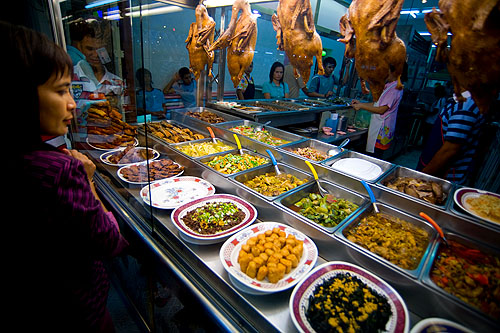
Sor Hueng 3 (Google Maps link)
79/16 Th Thamnoonvithi, Hat Yai
08 1896 3455
4pm-3am
Hat Yai also has two pretty good night markets. The most famous is located north of the centre of town and is a great place to sit down to a dish of the local deep-fried chicken, a southern-style curry, a dish or khanom jeen, or some local seafood:

Hat Yai's Night Market (Google Maps link)
Th Montri 1
6pm-late
Another night market, located slightly closer to the centre of town, specialises in take-away southern Thai eats:
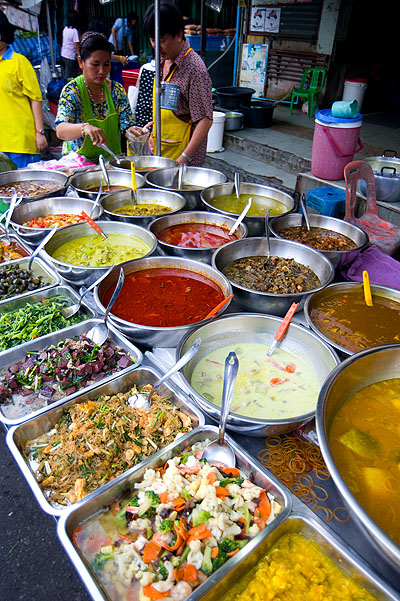
Hat Yai's Night Market (Google Maps link)
View Thai Eats in a larger map
 I happened to be in Pattani, one of Thailand's most Muslim cities, during Ramadan. I had read about the post-fasting markets held in Muslim countries during this holiday, and after talking to a few motorcycle taxi drivers, learned that was a large one held not far from Pattani's central mosque:
I happened to be in Pattani, one of Thailand's most Muslim cities, during Ramadan. I had read about the post-fasting markets held in Muslim countries during this holiday, and after talking to a few motorcycle taxi drivers, learned that was a large one held not far from Pattani's central mosque:

















 On the surface, Khao Noi appears to be your typical southern Thai-style raan khao kaeng, curry restaurant. A closer look reveals that Khao Noi is anything but ordinary. The tiny restaurant prepares nearly 50 dishes on a daily basis:
On the surface, Khao Noi appears to be your typical southern Thai-style raan khao kaeng, curry restaurant. A closer look reveals that Khao Noi is anything but ordinary. The tiny restaurant prepares nearly 50 dishes on a daily basis:

 For the first time I'll be attending, and blogging about, the Four Seasons Bangkok's annual World Gourmet Festival. This year is the 10th anniversary of the event, and chefs such as David Kinch, from the acclaimed
For the first time I'll be attending, and blogging about, the Four Seasons Bangkok's annual World Gourmet Festival. This year is the 10th anniversary of the event, and chefs such as David Kinch, from the acclaimed  When at home in Bangkok I tend to eat a pretty western-style breakfast (toast, eggs, yogurt), so when I'm on the road in different parts of Thailand I really look forward to getting my hands on a domestic breakfast. I certainly wasn't disappointed in Songkhla, an atmospheric seaside town in southern Thailand. The southern Thais have some of the best morning eats in the country, and Songkhla was no exception. It was a morning of several southern Thai specialties and sweet coffee in several different locations.
When at home in Bangkok I tend to eat a pretty western-style breakfast (toast, eggs, yogurt), so when I'm on the road in different parts of Thailand I really look forward to getting my hands on a domestic breakfast. I certainly wasn't disappointed in Songkhla, an atmospheric seaside town in southern Thailand. The southern Thais have some of the best morning eats in the country, and Songkhla was no exception. It was a morning of several southern Thai specialties and sweet coffee in several different locations.





 Hat Yai is a large, rather unattractive town in southern Thailand. It's by no means a destination, but because the city serves as a crossroads to many places farther south, I've spent quite a few nights here over the years. Fortunately there are worse places to be stuck, particularly if you count eating as one of your hobbies. The residents of Hat Yai are a mix of Thais, Chinese and Muslims and they have provided the city with an interesting restaurant scene. Just in case you happen to find yourself stuck in Hat Yai at some point, I've put together a short list of the places that have caught my attention over the years that I've been going there.
Hat Yai is a large, rather unattractive town in southern Thailand. It's by no means a destination, but because the city serves as a crossroads to many places farther south, I've spent quite a few nights here over the years. Fortunately there are worse places to be stuck, particularly if you count eating as one of your hobbies. The residents of Hat Yai are a mix of Thais, Chinese and Muslims and they have provided the city with an interesting restaurant scene. Just in case you happen to find yourself stuck in Hat Yai at some point, I've put together a short list of the places that have caught my attention over the years that I've been going there.





 Operating since 1983, Shoshana must be the longest-standing Israeli restaurant in the Khao San Road area, if not in all of Bangkok. Nowadays there are several places in the area serving pitas, felafel and even shwarma, but I inevitably go back to Shoshana. This used to be partially for the constant stream of Seinfeld re-runs being played there (I've never owned a TV), but was mostly for a delicious break from Thai food.
Operating since 1983, Shoshana must be the longest-standing Israeli restaurant in the Khao San Road area, if not in all of Bangkok. Nowadays there are several places in the area serving pitas, felafel and even shwarma, but I inevitably go back to Shoshana. This used to be partially for the constant stream of Seinfeld re-runs being played there (I've never owned a TV), but was mostly for a delicious break from Thai food. Other than noodles, the greatest contribution the Chinese have made to Thai cooking, at least in my opinion, is khao tom. The Thai words literally mean "boiled rice," but in this case they refer to restaurants that serve a variety Chinese/Thai dishes to order, often with small bowls of watery rice. One of my favourite khao tom places in Bangkok is Khao Tom Jay Suay, an ancient shophouse restaurant in Chinatown. The restaurant is colloquially known as Khao Tom Roy Pee, "100 Year Old Khao Tom," but I was told it's really only about 50 years old.
Other than noodles, the greatest contribution the Chinese have made to Thai cooking, at least in my opinion, is khao tom. The Thai words literally mean "boiled rice," but in this case they refer to restaurants that serve a variety Chinese/Thai dishes to order, often with small bowls of watery rice. One of my favourite khao tom places in Bangkok is Khao Tom Jay Suay, an ancient shophouse restaurant in Chinatown. The restaurant is colloquially known as Khao Tom Roy Pee, "100 Year Old Khao Tom," but I was told it's really only about 50 years old.

 Cambodia isn't generally known as a culinary destination, but I really enjoyed the eats during five recent days in Siem Reap. The quality of the city's foreign cuisine, particularly its French, was much better than that of a huge city like Bangkok. Among other meals, we had a fun lunch at
Cambodia isn't generally known as a culinary destination, but I really enjoyed the eats during five recent days in Siem Reap. The quality of the city's foreign cuisine, particularly its French, was much better than that of a huge city like Bangkok. Among other meals, we had a fun lunch at 

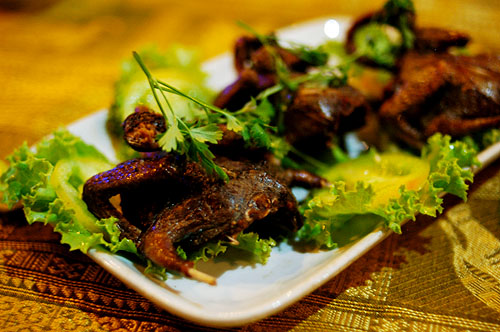

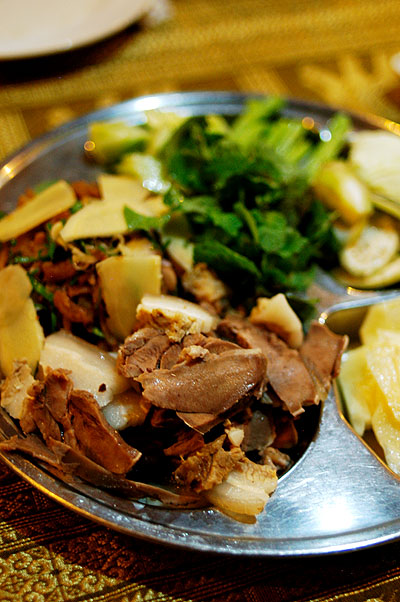


 As mentioned previously, Mae Hong Son was pretty wet, so we spent a lot of our time indoors, much of it eating and drinking. Of all the things we consumed there, I'm pretty sure that the local sweets were the biggest hit among the two chefs. We bought several banana leaf packages of the sweets on a daily basis, and they never seemed to tire of them.
As mentioned previously, Mae Hong Son was pretty wet, so we spent a lot of our time indoors, much of it eating and drinking. Of all the things we consumed there, I'm pretty sure that the local sweets were the biggest hit among the two chefs. We bought several banana leaf packages of the sweets on a daily basis, and they never seemed to tire of them.

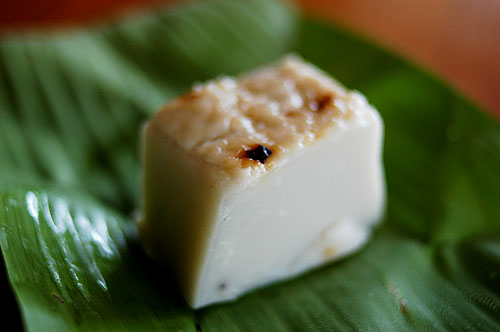
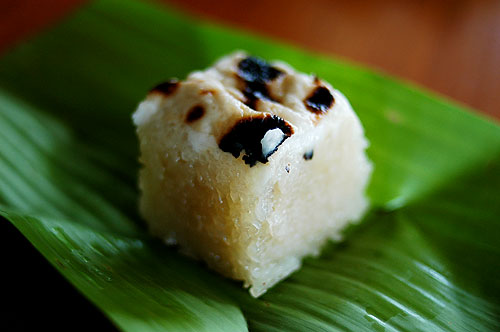

 Heaps of exposure this month: in addition to pieces in about four different in-flight mags, if you rush to your local bookist you can find two pieces I did in this this month's Travel + Leisure Southeast Asia, including a roundup of the best places to get your khao soi on in Chiang Mai. I contributed a short piece on Bangkok eats to this month's Saveur (there's also
Heaps of exposure this month: in addition to pieces in about four different in-flight mags, if you rush to your local bookist you can find two pieces I did in this this month's Travel + Leisure Southeast Asia, including a roundup of the best places to get your khao soi on in Chiang Mai. I contributed a short piece on Bangkok eats to this month's Saveur (there's also  How many different dishes can one make with some form of carbohydrate, shrimp and the occasional pork rind? Leave it to the Vietnamese to have created a fantastic number of dishes using these relatively limited ingredients, all of them creative and delicious.
How many different dishes can one make with some form of carbohydrate, shrimp and the occasional pork rind? Leave it to the Vietnamese to have created a fantastic number of dishes using these relatively limited ingredients, all of them creative and delicious.


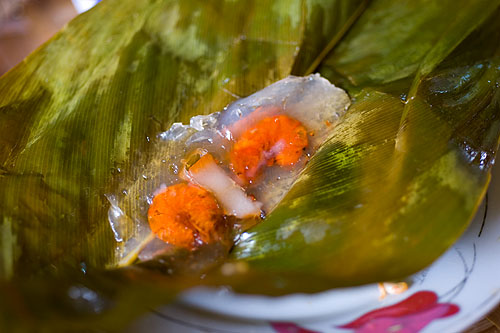
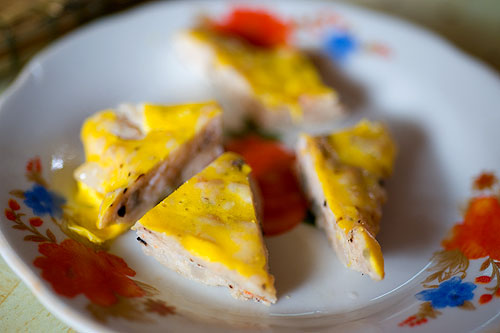
 Often it's little more than an atmospheric locale that draws me a to a particular vendor or restaurant:
Often it's little more than an atmospheric locale that draws me a to a particular vendor or restaurant:



 I must admit that of the reasons I was most excited to visit Vietnam was because I knew I'd be able to consume bánh mì, Vietnamese-style baguette sandwiches, on a daily basis. This dish is virtually non-existent in Bangkok, and is in my opinion, the perfect sandwich. Unfortunately, other than coincidentally stumbling across the same delicious bánh mì in Saigon that was
I must admit that of the reasons I was most excited to visit Vietnam was because I knew I'd be able to consume bánh mì, Vietnamese-style baguette sandwiches, on a daily basis. This dish is virtually non-existent in Bangkok, and is in my opinion, the perfect sandwich. Unfortunately, other than coincidentally stumbling across the same delicious bánh mì in Saigon that was 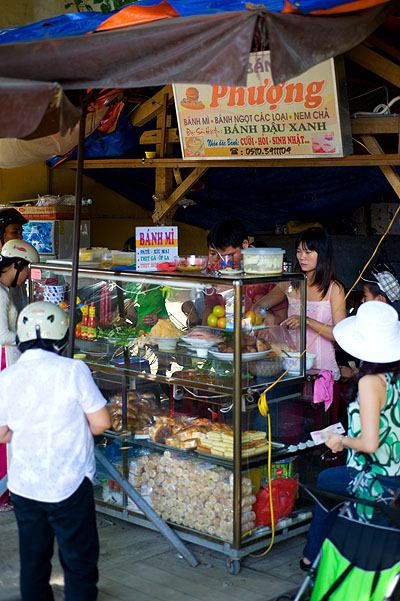

 I didn't really take to Hoi An. Don't get me wrong, the city's famed Chinese and French-colonial-style buildings were beautiful, and the setting was pleasant. But virtually every single structure seemed dedicated to selling t-shirts or overpriced food to tourists, and there seemed to be more of the latter than locals. And on top of all this, when I was in town, the town's central market was in the process of being rebuilt, which apparently caused many of the local vendors I had read about at
I didn't really take to Hoi An. Don't get me wrong, the city's famed Chinese and French-colonial-style buildings were beautiful, and the setting was pleasant. But virtually every single structure seemed dedicated to selling t-shirts or overpriced food to tourists, and there seemed to be more of the latter than locals. And on top of all this, when I was in town, the town's central market was in the process of being rebuilt, which apparently caused many of the local vendors I had read about at 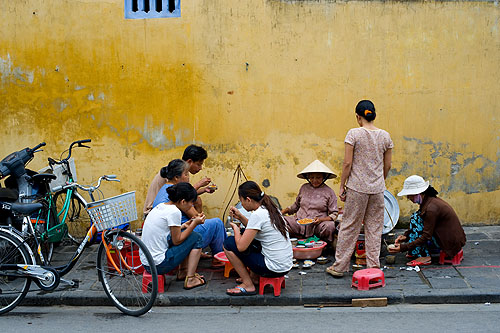
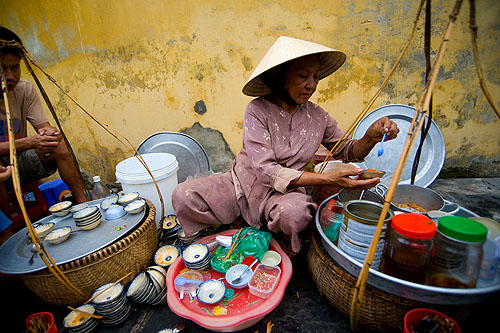
 Lonely Planet's Vietnam reckons that Bánh Xèo 46A makes the best bánh xèo in Saigon. I'm certainly no authority on the dish, a type of Vietnamese filled crepe, but I reckon Bánh Xèo 46A do the best version of the dish I've had.
Lonely Planet's Vietnam reckons that Bánh Xèo 46A makes the best bánh xèo in Saigon. I'm certainly no authority on the dish, a type of Vietnamese filled crepe, but I reckon Bánh Xèo 46A do the best version of the dish I've had. I had nearly forgotten about the Vietnamese obsession with noodles. Virtually every dish you encounter in this country contains some sort of doughy strand. There are so many noodle options I've yet to even consume a single dish of phở, arguably Vietnam's most recognized noodle dish.
I had nearly forgotten about the Vietnamese obsession with noodles. Virtually every dish you encounter in this country contains some sort of doughy strand. There are so many noodle options I've yet to even consume a single dish of phở, arguably Vietnam's most recognized noodle dish.



 As mentioned previously, this is a bit of a whirlwind trip, which leaves me relatively little time to explore dining options on my own. Knowing I'd be in Saigon I went directly to
As mentioned previously, this is a bit of a whirlwind trip, which leaves me relatively little time to explore dining options on my own. Knowing I'd be in Saigon I went directly to 



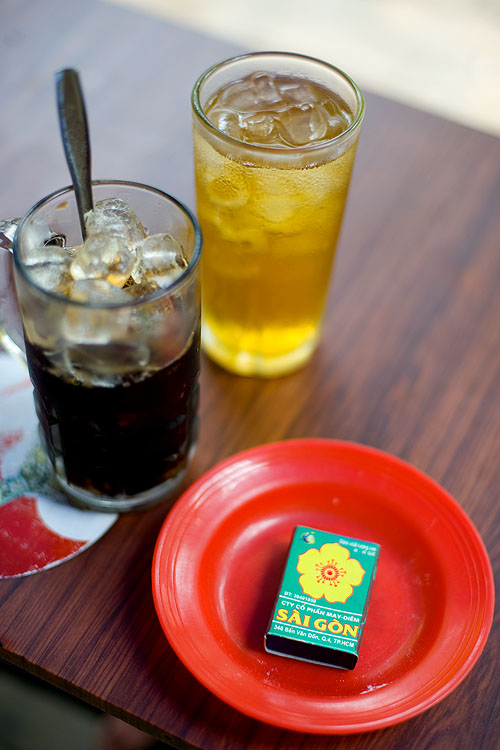 The Socialist Republic of Vietnam, that is.
The Socialist Republic of Vietnam, that is.